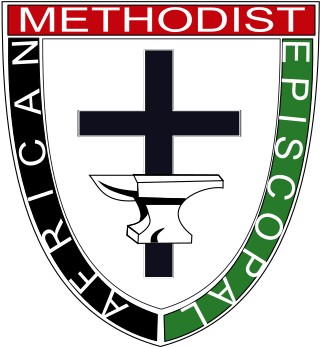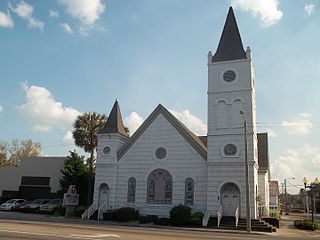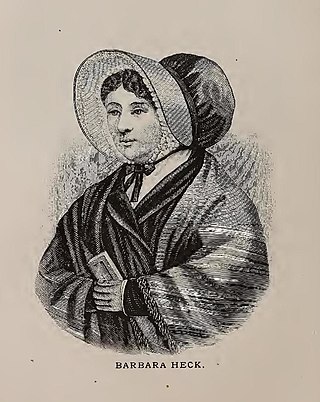Related Research Articles
Methodism, also called the Methodist movement, is a group of historically related denominations of Protestant Christianity whose origins, doctrine and practice derive from the life and teachings of John Wesley. George Whitefield and John's brother Charles Wesley were also significant early leaders in the movement. They were named Methodists for "the methodical way in which they carried out their Christian faith". Methodism originated as a revival movement within Anglicanism originating out of the Church of England in the 18th century and became a separate denomination after Wesley's death. The movement spread throughout the British Empire, the United States, and beyond because of vigorous missionary work, and today has about 80 million adherents worldwide.
The Methodist Episcopal Church (MEC) was the oldest and largest Methodist denomination in the United States from its founding in 1784 until 1939. It was also the first religious denomination in the US to organize itself nationally. In 1939, the MEC reunited with two breakaway Methodist denominations to form the Methodist Church. In 1968, the Methodist Church merged with the Evangelical United Brethren Church to form the United Methodist Church.
The Methodist Episcopal Church, South was the American Methodist denomination resulting from the 19th-century split over the issue of slavery in the Methodist Episcopal Church (MEC). Disagreement on this issue had been increasing in strength for decades between churches of the Northern and Southern United States; in 1845 it resulted in a schism at the General Conference of the MEC held in Louisville, Kentucky.
The Holiness movement, also known as the Wesleyan–Holiness movement, is a Christian movement that emerged chiefly within 19th-century Methodism, and to a lesser extent influenced other traditions such as Quakerism, Anabaptism, and Restorationism. The movement is historically distinguished by its emphasis on the doctrine of a second work of grace, generally called entire sanctification or Christian perfection and by the belief that the Christian life should be free of sin. For the Holiness movement, "the term 'perfection' signifies completeness of Christian character; its freedom from all sin, and possession of all the graces of the Spirit, complete in kind." A number of evangelical Christian denominations, parachurch organizations, and movements emphasize those beliefs as central doctrine.

The African Methodist Episcopal Church, usually called the AME Church or AME, is a Methodist Black church. It adheres to Wesleyan-Arminian theology and has a connexional polity. The African Methodist Episcopal Church is the first independent Protestant denomination to be founded by black people; though it welcomes and has members of all ethnicities.
The Confessing Movement is a largely lay-led theologically conservative Christian movement that opposes the influence of theological liberalism and theological progressivism currently within several mainline Protestant denominations and seeks to return them to its view of orthodox doctrine, or form a new denomination and disfellowship (excommunicate) them if the situation becomes untenable. Those who eventually deem dealing with theological liberalism and theological progressivism within their churches and denominations as not being tenable anymore would later join or start Confessional Churches and/or Evangelical Churches that continue with the traditions of their respective denominations and maintaining orthodox doctrine while being ecclesiastically separate from the Mainline Protestant denominations.

The African Methodist Episcopal Zion Church, or the AME Zion Church (AMEZ) is a historically African-American Christian denomination based in the United States. It was officially formed in 1821 in New York City, but operated for a number of years before then. The African Methodist Episcopal Zion Church adheres to Wesleyan-Arminian theology.
The Primitive Methodist Church is a Methodist Christian denomination within the holiness movement. It began in England in the early 19th century, with the influence of American evangelist Lorenzo Dow (1777–1834).
The Southern Methodist Church is a conservative Protestant Christian denomination with churches located in the southern part of the United States. The church maintains headquarters in Orangeburg, South Carolina.

The black church is the faith and body of Christian denominations and congregations in the United States that minister predominantly to, and are led by, African Americans, as well as these churches collective traditions and members. The term "black church" may also refer to individual congregations in traditionally white denominations.
The Methodist Church was the major Methodist denomination in Canada from its founding in 1884 until it merged with two other denominations to form the United Church of Canada in 1925. The Methodist Church was itself formed from the merger of four smaller Methodist denominations with ties to British and US Methodist denominations.
The Evangelical Church of North America (ECNA) is a Wesleyan-Holiness, Protestant Christian denomination headquartered in Clackamas, Oregon. As of 2000, the Church had 12,475 members in 133 local churches. The Church sponsors missionaries in seven countries.

Religion of black Americans refers to the religious and spiritual practices of African Americans. Historians generally agree that the religious life of black Americans "forms the foundation of their community life". Before 1775 there was scattered evidence of organized religion among black people in the Thirteen Colonies. The Methodist and Baptist churches became much more active in the 1780s. Their growth was quite rapid for the next 150 years, until their membership included the majority of black Americans.

Barbara Heck was an early American Methodist, known as the "mother of American Methodism."

Philip Embury was a Methodist preacher, a leader of one of the earliest Methodist congregations in the United States.
Methodist views on the ordination of women in the rite of holy orders are diverse.

The history of Methodism in the United States dates back to the mid-18th century with the ministries of early Methodist preachers such as Laurence Coughlan and Robert Strawbridge. Following the American Revolution most of the Anglican clergy who had been in America came back to England. John Wesley, the founder of Methodism, sent Thomas Coke to America where he and Francis Asbury founded the Methodist Episcopal Church, which was to later establish itself as the largest denomination in America during the 19th century.
The Bible Methodist Connection of Churches is a Methodist denomination within the conservative holiness movement.

Albert Carman was a Canadian Methodist minister and teacher who became head of the Methodist Church in Canada.
References
- ↑ "Free Methodist Church of North America | Protestantism". Britannica.com. Retrieved November 23, 2017.
- ↑ Snyder, Howard A. (2006). Populist Saints: B T and Ellen Roberts and the First Free Methodists. Grand Rapids: Eerdmans. ISBN 0-8028-2884-1.
- ↑ The Past Before Us: A History of Free Methodist Camp Meetings in Muskoka, 2002, ISBN 0-9686224-2-9, by Gary Denniss
- ↑ "Free Methodist Hill, a Centennial History", 1879–1979, Herald-Gazette, p. 2, 1979, by Gary Denniss
- ↑ Hutchings, Rosanne (1993). "Free Methodist Women in the Nineteenth Century". Canadian Society of Church History: 43–55. Retrieved October 18, 2013.
- ↑ Sigsworth, John Wilkins (1960). The Battle Was the Lord's. Sage. OCLC 615071826.